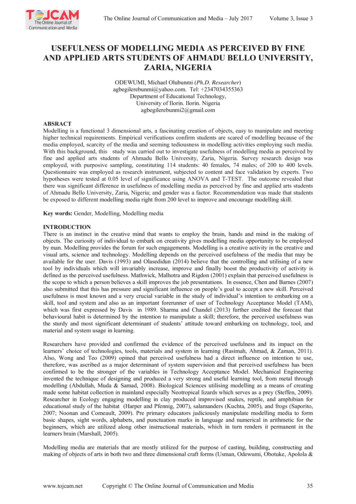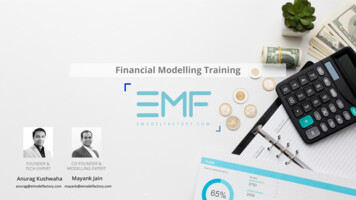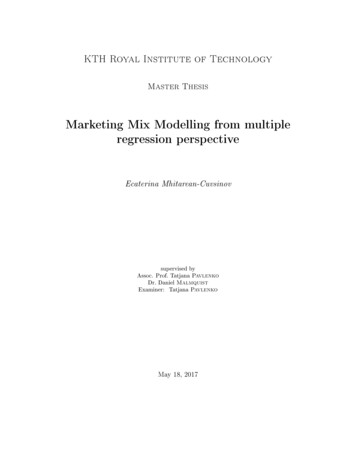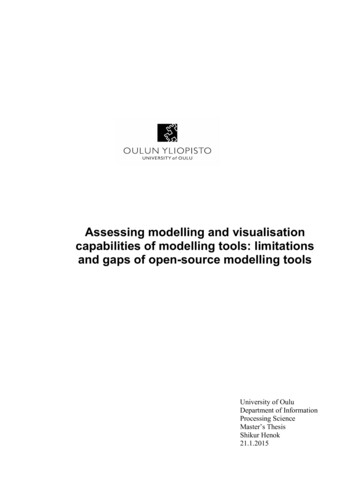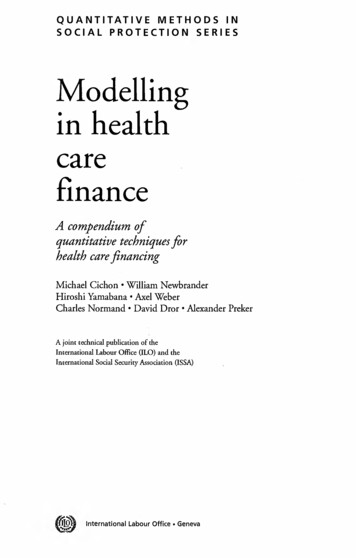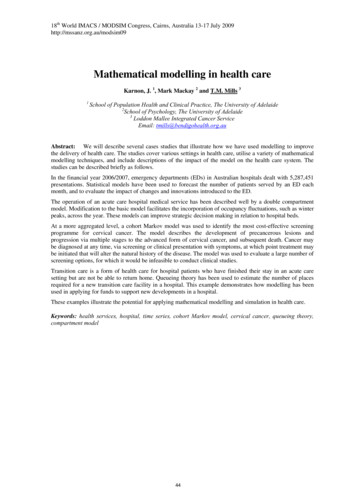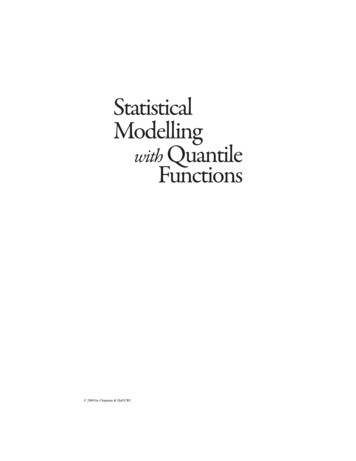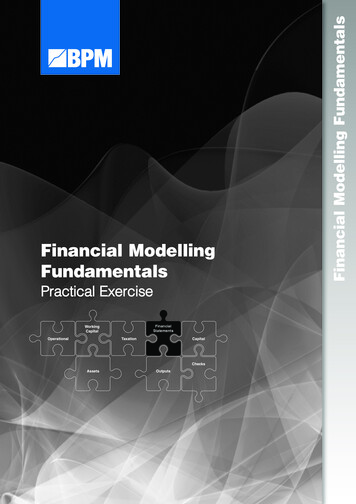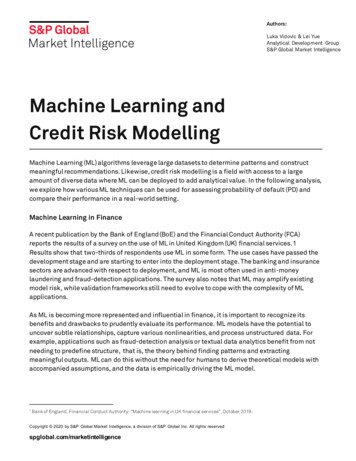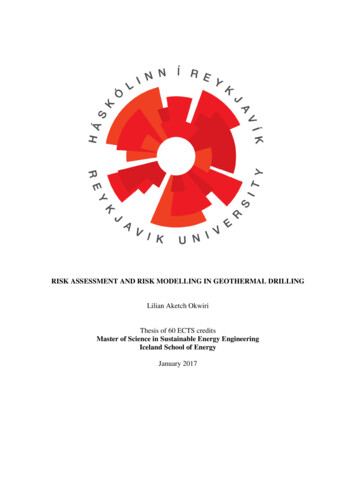
Transcription
RISK ASSESSMENT AND RISK MODELLING IN GEOTHERMAL DRILLINGLilian Aketch OkwiriThesis of 60 ECTS creditsMaster of Science in Sustainable Energy EngineeringIceland School of EnergyJanuary 2017
RISK ASSESSMENT AND RISK MODELLING IN GEOTHERMAL DRILLINGLilian Aketch OkwiriThesis of 60 ECTS credits submitted to the Iceland School of Energyat Reykjavík University in partial fulfilmentof the requirements for the degree ofMaster of Science in Sustainable Energy Engineering – ISEJanuary 2017Supervisors:Dr. María Sigríður GuðjónsdóttirAssistant Professor, Reykjavík UniversitySverrir ÞórhallssonIceland Geosurvey (ÍSOR)Examiner:Kristinn IngasonMannvit
RISK ASSESSMENT AND RISK MODELLING IN GEOTHERMAL DRILLINGLilian Aketch Okwiri60 ECTS thesis submitted to the Iceland School of Energyat Reykjavík University in partial fulfilmentof the requirements for the degree ofMaster of Science in Sustainable Energy Engineering – ISEJanuary 2017Student:Lilian Aketch OkwiriSupervisors:Dr. María Sigríður GuðjónsdóttirSverrir ÞórhallssonExaminer:Kristinn Ingason
ABSTRACTDevelopment of geothermal energy has advanced in the last few years and will continue to doso in the coming years. But this development is slowed by the high risks and costs associatedwith the drilling phase of geothermal development. The goal of this study was to find out therisk factors that can interrupt or delay the delivery, or compromise the quality of a geothermalwell and how these risks are perceived by drilling professionals in Iceland and in Kenya. Sixtyfour (64) risk factors were identified, an online questionnaire developed and the survey toolQuestionPro used to send out the survey. The results showed that drilling risk analysis issubjective and risks are ranked, or perceived to be high or low, depending on the project settingsuch as physical, economic and political environments. Generally, toxic gas release was rankedthe highest risk for drilling operations, followed by high cost of drilling and lost circulation.The second part of the study looked at the value of integrated cost and schedule risk in executionof drilling projects, allowing for accurate budget and schedule estimation. The project riskmanagement software RiskyProject was used for this purpose to simulate a sample drillingproject. The results show that cost and schedule risk management can play an important role ingeothermal drilling projects. The deterministic method of costs and schedule estimationcommonly in use could easily result in cost and schedule overruns or underruns due to theinfluence of risks and uncertainties encountered within and outside the project. A Monte Carlosimulation run on the sample drilling project showed that the P50 values giving the most likelyvalues for cost and schedule, gave a higher value than the base values determined for the project.P1/P99 range was 1,115,369 USD for cost and 343 hrs for schedule. The simulation showedthat drilling the 8½" section has the largest influence on the well completion time and thereforegreater effect on the cost and schedule of the drilling project.For further studies, the cost effects of the risk events should be studied as this was not possiblein this project. In conclusion, the risk management process has the potential to create value forall aspects of drilling projects. It also recommends that the geothermal drilling industry need toembrace risk management especially integrated cost and schedule risk management as a toolfor controlling of budget and schedule overruns.Key words: Drilling risks, Geothermal drilling, Risk management, Cost and scheduleestimationi
ACKNOWLEDGEMENTI wish to thank God for sustaining me throughout my study period at Reykjavik University and enablingme come this far.I am grateful to the Government of Iceland, the United Nations University, Geothermal Trainingprogram (UNU-GTP) and Geothermal Development Company (GDC), Ltd. of Kenya for theopportunity and financial support.My sincere gratitude goes to the UNU-GTP staff: Director, Lúðvík S. Georgsson, Deputy DirectorIngimar G Haraldsson, Málfríður Ómarsdóttir, Thórhildur Ísberg, and Markús A. G. Wilde for theirsupport, direction and guidance throughout my studies.Special thanks to my supervisors Dr. María Sigríður Guðjónsdóttir and Sverrir Þórhallsson for patientlyguiding and supporting me through this thesis and making sure that I was focused. I appreciate youtaking your time every week to meet with meI appreciate the support and assistance from Björn Már Sveinbjörnsson, who assisted in this workselflessly.Special thanks to Carine Chatenay for taking her time to share with me knowledge in the field of riskmanagement as well as for her guidance.I wish to thank my colleagues from GDC especially Thomas Miyora for his support and providinginformationMy friends and classmates at Iceland school of energy and fellows at UNU-GTP for their support andencouragement who have been for me an inspiration, motivation and source of knowledge through thisprocess, especially Christopher Mathews for taking his time to proof read my work.Finally, special gratitude to my parents, brothers and husband David, for their encouragement, love,support, and their prayers.ii
TABLE OF CONTENTSABSTRACT . iACKNOWLEDGEMENT . ii1. INTRODUCTION . 11.1 Objectives and goals . 32. METHODS. 42.1 Literature review. 42.1.1 Nature of the drilling industry. 42.1.2 Drilling industry organisation . 62.2 Project life cycle . 72.2.1 Well design . 82.2.2. Operations planning . 92.2.3. Mobilization . 112.2.4. Drilling operations . 112.2.5. Demobilization . 112.2.6. Documentation and experience transfer . 122.3 Concept of risk and risk management process . 122.3.1 Risk . 122.3.2 Risk management . 123. RISK MANAGEMENT IN THE DRILLING PROCESS . 203.1. Risks in the geothermal drilling process . 203.1.1. Technical risks . 203.1.2 Health, safety and environment . 263.1.3. Financial risk . 283.1.4 Legal risk . 303.1.5 Organisation risk . 303.1.6 Policy and political risk . 323.2 Survey questionnaire . 323.2.1 Survey structure . 333.2.2 Risk measurement and scale . 333.3 Integrated cost and schedule . 363.3.1 Project schedule . 373.3.2 Cost estimates . 393.3.4 Risk data. 403.4 Simulation . 434. RESULTS. 454.1 Questionnaire results . 454.1.2 Demographic survey . 454.1.3 Drilling risk ranking . 474.2 Integrated cost and schedule results . 504.2.1 Drilling schedule and cost . 504.2.2 Risk register . 514.3 Monte Carlo analysis results. 535. SUMMARY AND DISCUSSION . 606. CONCLUSION . 647. RECOMMENDATION AND FUTURE WORK . 65REFERENCES . 66APPENDIX A: Questionnaire . 71APPENDIX B: Risk Matrix . 72iii
LIST OF FIGURES1. Personnel involved in drilling a well . 62. Project life cycle phases . 73. Risk management process . 134. Monte Carlo simulation process . 175. Resources and costs . 396. Part of the risk register from RiskyProject . 417. Cost view in RiskyProject . 418. Respondent by country . 459. Respondent by years of experience . 4610. Respondent by position held. 4611. Using risk management systems. 4712. Impact of drilling risks on drilling schedule, cost and well completion . 4713. The resultant risk register from RiskyProject . 5114. Risk matrix without mitigations . 5215. Risk matrix with mitigations . 5316. Drilling timeline after simulation . 5417. Probability and cumulative distribution of the drilling cost. . 5518. Probability and cumulative distribution of drilling duration. . 5619. Probability and cumulative distribution of the finish time. . 5720. Sensitivity to finish time of tasks . 5821. Sensitivity of activities in the 8½" section to finish time . 59LIST OF TABLES1. Drilling project in project life cycle . 72. Typical geothermal well design in Kenya . 113. Probability definitions . 154. Probability categories . 155. Risk rating consequences/impact. 166. Risk matrix . 167. Drilling risk register. 198. Drilling risks in literature . 219. Effects of H2S at deferent concentration . 2610. Risk measurement scale. 3411. Risk breakdown structure . 3512. Daily operating cost . 4013. Cost estimation . 4214. Gradation scale for quantitative comparison of alternatives . 4315. Pairwise comparison in RiskyProject . 4416. Respondent by country . 4517. Respondent by years of experience . 4618. Respondent by position held. 4619. Using risk management systems. 4720. Top risks as ranked by all respondents . 4821. Top risks as ranked by Icelandic respondents . 4822. Top risks as ranked by Kenyan respondents . 4823. Results from questionnaire . 4924. Corresponding percentiles values for the project costs . 5525. Corresponding percentiles values for the project duration . 5626. Corresponding percentiles values for the project finish dates . 57iv
v
1. INTRODUCTIONThe role of geothermal in providing green renewable energy in a sustainable manner,particularly in mitigating climate change, is evident as its development increases. In January2016, the installed global capacity of geothermal power generation was about 13.3 GW across24 countries. A further 12.5 GW of planned capacity across 82 countries is currently underdevelopment and if all the planned projects stay on course, the global geothermal industry isexpected to reach about 18.4 GW by 2021 and 32 GW by the early 2030s (GEA, 2015). Despitethis increased development and geothermal energy’s advantage over other renewable sourcessuch as indifference to weather, base load capability, great stability and high thermal efficiency(Li, 2013), adoption of geothermal power is slowed by the uncertainty and risks involved indevelopment, high initial costs and relative inaccessibility of easily tapped geothermalresources (IGA, 2013).Geothermal drilling is a fundamental phase of geothermal development and it carriesconsiderable risk in terms of costs, schedule and project completion. Drilling is carried out forseveral reasons, the main one being to produce steam and water for energy generation. Otherobjectives of drilling are to prove existence of a resource, the extent and size of the reservoirand to confirm the sustainability of the resource. Drilling conditions contribute significantly torisks during the drilling process. These risks are numerous and include down-hole geologicconditions, location of the target reservoir, prevailing reservoir conditions, availabletechnology, equipment and resources, experience of the drilling personnel and wellspecifications. The consequences of these risks are undesirable and can have implications onproject completion, economic performance, professional reputation, environmental impact andpersonnel safety. Risk management, especially cost and schedule risks, should consequently bean integral part of any geothermal drilling project to minimize events that threaten to delay theproject, compromise quality of the drilled well, cause the project to go over budget and causeharm to project personnel.According to Kullawan (2012) drilling operations have three basic objectives:i. Safe drilling, even in situations where the drilling project will be delayed or incur extracost.ii. Drilling a fit-for-use well that should fulfil the purpose for which it was constructed.Borehole integrity should be maintained, design requirements met and the well should allowfor testing and production or any other future works to be done on it.iii. Minimized cost of drilling a well, obtained through optimization of drilling process and bydrilling time reduction. Drilling costs comprise of approximately 40 percent of the totalinvestment cost of a geothermal project (Þórhallsson & Sveinbjörnsson, 2012). This isdirectly influenced by the time taken to drill and complete the wells (Okwiri, 2013). Risksand uncertainty in the drilling process result in more days to complete the work thanplanned; this in turn increases the cost, as most of the charges for the drilling are based ona per-day rate.Drilling risks and uncertainties result in drilling projects not only going off the critical path ofthe planned drilling operations, but also create unsafe working conditions, diminish the integrityof the well and increase the cost of drilling significantly. Drilling risks also impact the projectin terms of the schedule, such that drilling time is spent on mitigation measures instead of well1
construction, directly or indirectly adding to the cost of the well. These risks are usually notwell accounted for in planning of projects costs and their control. There are several methods ofproject and schedule cost estimation. The two most common methods are the use of contingencyor reserve amount and the three-point method to account for cost uncertainties that could arisefrom the project.Contingency or reserve amountTime contingency is the additional time allocated above the schedule time, while costcontingency is the additional funds allocated above the budgeted amount. This is done to coverany eventualities that would result in delay or additional cost as the project progresses. It canbe a percentage increase of the activity duration and the budget, or it can be a fixed durationand amount of money added to the original estimates.The three-point methodThis method is used when duration and cost of activities are not known for certain and is basedon determining three types of estimates (PMBOK, 2013):i. Most likely. This scenario gives the most realistic time and cost an activity will requireunder normal conditions to achieve its goals.ii. Optimistic. This is the best case scenario where conditions are favourable and the costand time may be lower than the most likely estimate.iii. Pessimistic. This gives the worst case scenario of the cost and time requirement whenthe conditions are unfavourable.There are numerous project uncertainties including task duration, start and finish times, quality,safety, technology costs and resources uncertainties. The recommended practice (RP) ofAmerican association of cost engineering (AACE) International, presents methods forintegrated analysis of schedule and cost risk to estimate the appropriate level of cost andschedule contingency reserve on projects. It presents the need to include the impact of schedulerisk on cost risk in the project in a manner that mitigation can be conducted in a cost effectiveway. These methods allow for the integration of the cost estimate with the project schedule byresource-loading and costing the schedule’s activities and risks. The risks and costs that theyaffect are then linked activities (Shen, Wu, & Ng, 2001).It is important to understand and manage the level of risk involved in any drilling project, interms of integrated cost and schedule risk management to ensure that there are adequateresources to maintain and complete the project should the worst case outcomes occur. Integratedcost and schedule risk management provides a two-step process for allocating project cost tothe projects: first, by allocating resource costs such as daily operating rates to drilling activitiesand then second, by allocating cost to materials and consumables such as casing and drillingbits used in the project. A further integration of risks into the cost and schedule planning reducesthe instances of project cost and schedule overruns.This thesis looks at a risk incorporated integrated cost and schedule risk management to allowfor proper planning of budgeted costs and their control. This provides an easier way ofaccounting for activities outside the critical path that add cost and time to the planned projectpath.This thesis is presented in five main parts. Chapter 1 introduces the study and gives the researchpurpose, objectives and goals. Chapter 2 gives the methods used in the thesis. It starts byoutlining the structure of a drilling project and details it in a project life cycle. A general risk2
management foundation is then described. Chapter 3 deals with a detailed risk managementprocess for a drilling project, drilling risk are identified and described. This chapter goes furtherand describes how these risks are analysed and evaluated. A questionnaire is used to gain insighton risks in the industry and its structure is described here. Finally, an integrated cost andschedule risk management tool – RiskyProject is introduced. In Chapter 4, the results obtainedfrom the survey and the integrated cost and schedule risk management tool are analysed.Finally, Chapter 5 gives the summary and discussion of results. Finally, Chapter 6 gives theconclusion and Chapter 7 gives recommendation and future work.1.1 Objectives and goalsThe main objective of this thesis was to identify, through the relevant literature and drillingprofessionals’ experience, the risks that threaten the on-time delivery of geothermal wells andincrease the cost of drilling geothermal wells and to examine the impact these risks have ongeothermal development projects. It also looked at how drilling professionals perceive risks intwo countries, Iceland and Kenya. The thesis also intended to define a suitable framework forrealizing a process-driven risk management for drilling projects.To accomplish this, the following research topics were formulated:i. Identify the key risk factors that can interrupt or delay the delivery, or compromise thequality, of a geothermal well in each phase of the drilling project.ii. Assess the perception of the risk according to industrial practitioners in terms ofprobability of occurrence and severity.iii. Review an integrated cost and schedule analysis model that can be used to support therisk management process and implement such a tool on a sample drilling project toquantify the impacts of the identified risk factors on the drilling project.3
2. METHODSThis chapter describes in details the methodology and tools used to collect, analyse, assess andevaluate drilling risks in this project. It explains the data collection procedures and researchstrategy, design, target population and sample size.The methodology adopted for this thesis is described in three parts. First, a literature reviewthat was done is described, where a theoretical framework of the drilling industry and drillingrisks were presented and the risk management process also discussed. This was followed by anonline survey questionnaire sent to personnel in the geothermal drilling industry to quantifythese identified risks. Finally, an integrated cost and schedule risk analysis was carried out usingMonte Carlo simulation on a sample drilling project with a risk management support tool,RiskyProject.2.1 Literature reviewIn this section the available literature on geothermal drilling is reviewed in order to identifyrisks involved. It starts out explaining the nature and organisation of the drilling industry,followed by project life cycle in the drilling project. Those risks that affect the drilling operationphase are discussed in detail. Risks in the drilling phase are identified both on individual jobsand on the whole process.2.1.1 Nature of the drilling industryThe drilling industry is a unique industry where practically all construction goes onunderground. It is an industry that requires specialized equipment and highly skilled personnel.Geothermal drilling adapts heavily from oil and gas drilling in terms of tools, equipment andeven drilling methods. The operations are standardized worldwide, but there are differences inhow different types of wells are drilled based on their purpose. Axelsson et al. (2013) lists eighttypes of geothermal wells and how they differ in terms of construction and purpose. Theseinclude:i. Temperature gradient wellsii. Exploration wellsiii. Production wellsiv.Step-out wellsv. Make-up wellvi.Reinjection wellsvii.Monitoring wellsviii. Unconventional wellsFor most geothermal projects, drilling operations are usually contracted; however, some ownersare choosing to own and carry out their own drilling operations in-house (Khan, 2015). Thereare three different types of contracts used in the drilling industry to provide the background forcontractor payment and the allocation of risks in the drilling project (Anderson, 1971). Becauseeach contract provides different incentives for the contractor, proper contract management isimportant in reducing drilling risks and ensuring well success. These contracts include:4
i.Day rate – The day rate contract is commonly used today. The well owner or operatorprovides a comprehensive drilling program to direct the contractor on how to proceedwith the well, along with all well consumables and any other services required for thewell. The drilling contractor provides drilling equipment and personnel to drill the well.The owner and the contractor agree on a fixed daily rate for every day spent on drilling(Miyora, 2014). The daily rate usually covers for rental of drilling rig and otherequipment and the cost of personnel and expatriates. When operations outside thedefinite jobs for the drilling contractor are carried out, a stand-by-rate is charged. Undera day rate contract, the operator normally shoulders all the risk of delay unless theincident is caused by negligence on part of the contractor (Anderson, 1971). Thecontractor in this type of arrangement is only liable for risks associated with theequipment, services provided and labour provision. All the other risks remain with theoperator.ii.Meter rate – also known as per footage rate. A few geothermal drilling project uses thistype of contract including drilling projects in Iceland. Similar to the day rate, the owneror operator of the well provides the program for drilling the well. The drilling contractorprovides the equipment and crew. The difference is that the contractor is paid an agreed
Minimized cost of drilling a well, obtained through optimization of drilling process and by drilling time reduction. Drilling costs comprise of approximately 40 percent of the total investment cost of a geothermal project (Þórhallsson & Sveinbjörnsson, 2012). This is
